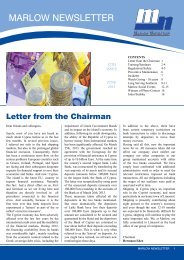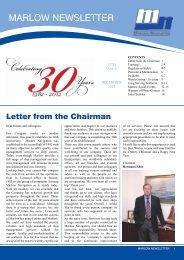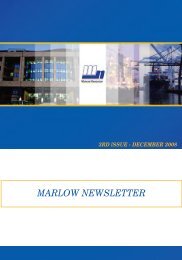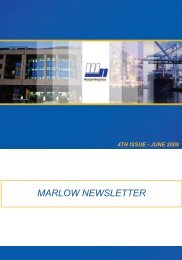Newsletter 7th Issue LASER.qxp:Layout 1 - Marlow Navigation
Newsletter 7th Issue LASER.qxp:Layout 1 - Marlow Navigation
Newsletter 7th Issue LASER.qxp:Layout 1 - Marlow Navigation
Create successful ePaper yourself
Turn your PDF publications into a flip-book with our unique Google optimized e-Paper software.
<strong>7th</strong> <strong>Issue</strong><br />
Dec 2010<br />
Marine Story<br />
The Problem of Longitude<br />
Life before SAT NAV<br />
So what was the problem and how was it<br />
solved<br />
Go onto any ship’s bridge these days and<br />
you’ll have the ship’s position in latitude<br />
and longitude to an accuracy of a few<br />
metres. Thanks to satellite navigation and<br />
global positioning systems, the ability to<br />
determine position on the surface of the<br />
earth is a simple readout from a satellite<br />
receiver.<br />
Latitude was easily determined.<br />
Measuring the maximum elevation of the<br />
sun with a sextant as it crossed your<br />
meridian at noon allowed the early<br />
navigators to obtain their latitude.<br />
Because lines of latitude are parallel, the<br />
concept of sailing ‘east’ or ‘west’ along a<br />
line of latitude round the earth was easy.<br />
But it was not always like this. Back in the<br />
1700’s, the problem of ‘finding longitude’<br />
was stretching the minds of everyone as<br />
more and more sailing ships set out to<br />
explore new territories, to conquer lands<br />
and bring commodities from foreign<br />
countries. There was no practical way to<br />
determine longitude and despite the best<br />
navigational charts and compasses, Vasco<br />
da Gama, Ferdinand Magellan and Sir<br />
Francis Drake were all getting to their<br />
destinations by good luck or the Grace of<br />
God! Even Captain William Bligh on the<br />
‘Bounty’ and the circumnavigator Captain<br />
James Cook took various tools and<br />
devices to sea to test them but without<br />
result.<br />
Determining longitude was more tricky.<br />
In those days, the navigator needed to<br />
know the precise local time aboard the<br />
ship and also the time at the home port at<br />
the very same moment. The two clocks<br />
enabled the navigator to convert hourly<br />
difference into geographical separation.<br />
The earth takes approximately 24 hours<br />
to rotate once through 360 degrees, 1<br />
hour marks 15 degrees of spin on the<br />
surface. Every day the navigator reset his<br />
ship’s clock to local noon when the sun<br />
reaches the highest point in the sky. Then<br />
he would consult his ‘port’ clock - every<br />
hour’s difference between the two clocks<br />
translated into 15 degrees of longitude.<br />
There were no astronomical tables or<br />
almanacs in those days of course!<br />
30






